

ホーム > 野菜 > 野菜の情報 > サラダファーストを実証~野菜をサラダで食べることの魅力~
キユーピー株式会社 研究開発本部
技術ソリューション研究所
評価・解析研究部 部長 松岡 亮輔

はじめに
食後血糖値の上昇は耐糖能障害(糖尿病予備軍と言われる症状)の初期にみられ、糖尿病の発症ないしは心血管疾患のリスクになる。近年では、炭水化物の前に野菜を摂取することにより、食後血糖値の上昇が抑制されることが報告されている(1~3)、しかしながら、この効果が何によるものか、ほとんど知られていない。これを明らかにする目的で、私たちは食物繊維をターゲットとして、野菜サラダから固形分を取り除いた野菜サラダの搾り汁を炭水化物の前に摂取した時の、食後血糖値に及ぼす影響も評価した。
野菜の摂取と血糖値との関係
野菜を摂取することでさまざまな疾病のリスクを低減することが知られている。特に冠動脈疾患(心臓に血液を送る冠動脈が狭くなったり詰まったりして、心筋に十分な酸素が届かない病気)のリスクを低減することが知られており(4)、その原因となる、肥満、高脂血症、糖尿病、高血圧を改善することも知られている(5~9)。
例えばインドネシアの女性を対象に、1日あたり約400グラムの野菜をマヨネーズまたはドレッシングと一緒に摂取してもらうと体重が減少し、LDL-コレステロール(悪玉コレステロール)濃度が低下したことが報告されている。
糖尿病は、冠動脈疾患の危険因子であり、糖尿病患者は他のリスクファクターと比較して冠動脈疾患になるリスクが3倍になることも知られている(10)。
ベトナム人の2型糖尿病患者にマヨネーズ、ドレッシングを与え、2週間自由に使用してもらったところ、野菜の摂取量が増え、糖尿病の指標である血中フルクトサミン濃度が低下することが報告されている(図1)(11)。
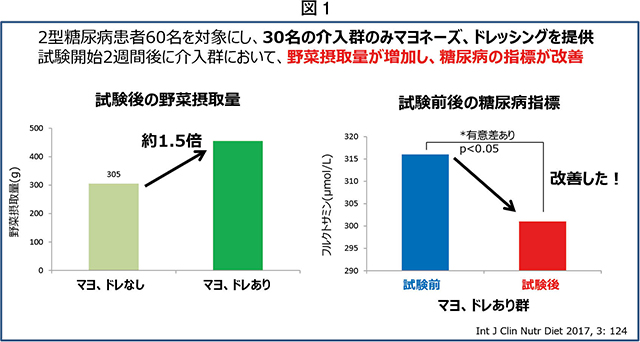
サラダファーストの食後血糖値上昇抑制
20歳以上の健常男性13人を対象に単回摂取クロスオーバー法(注1)で行った(ウォッシュアウト(注2)7日間)。3つのグループに分けられた被験者は一晩絶食後の空腹時に採血を行い、米飯→野菜サラダ、野菜サラダ→米飯、野菜サラダの搾り汁→米飯の3種類の順番をグループごとに変えて食事を摂取させた。被験食摂取30分、45分、60分、90分および120分後に採血を行い、血糖値を測定した(図2)。
その結果、血糖値は、野菜サラダ→米飯で、米飯→野菜サラダと比較して45分後に有意に低い値を示した。野菜サラダの搾り汁→米飯と、野菜サラダ→米飯、米飯→野菜サラダの間に有意差は認められなかった(図3)。
注1:「交差試験」とも呼ばれ、A群・B群を設定し、それぞれ別の試験物を摂取し、その後、摂取するものを順次入れ替えていく試験デザインのこと。
注2:試験を行わない期間。
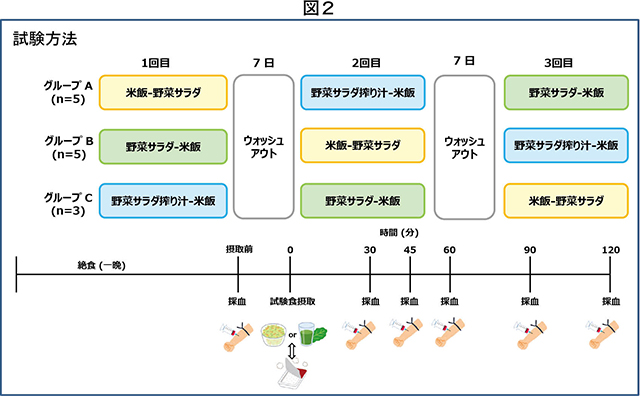
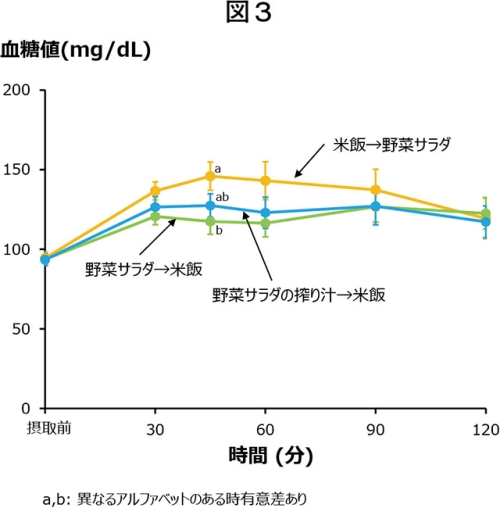
その結果、血糖値は、野菜サラダ→米飯で、米飯→野菜サラダと比較して45分後に有意に低い値を示した。野菜サラダの搾り汁→米飯と、野菜サラダ→米飯、米飯→野菜サラダの間に有意差は認められなかった(図3)。
注1:「交差試験」とも呼ばれ、A群・B群を設定し、それぞれ別の試験物を摂取し、その後、摂取するものを順次入れ替えていく試験デザインのこと。
注2:試験を行わない期間。


食物繊維の効果
食物繊維は、胃での滞留時間が長いことが報告されている(12)。このことから、野菜サラダを先に摂取することで後に摂取した炭水化物の吸収を遅らせたことが考えられた。本試験では、野菜サラダの搾り汁-米飯の食後血糖値は、米飯-野菜サラダと比較して有意差は無く、その効果は弱いことが分かった。その理由は、食物繊維の含量が考えられた。野菜サラダの食物繊維含量は2.0g/100gであるの対して、野菜サラダの搾り汁の食物繊維含量は0.2g/100gであった(表)。
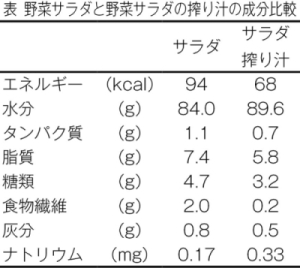

咀嚼(そしゃく)の効果
野菜サラダと野菜サラダの搾り汁の違いは噛むことである。咀嚼力と糖尿病の関係を調べた疫学研究では、咀嚼力の強いグループは咀嚼力の弱いグループと比較して糖尿病のリスクを低減したことが報告されている(13)。また、咀嚼の回数が多いとインスリンの分泌が増え、食後の血糖値の上昇を抑制することが報告されている(14)。
咀嚼の効果について、キャベツの摂取は、米飯、ゆで卵、魚、ソーセージなどと比較して、咀嚼回数が増えることが報告されている(15)。咀嚼回数が増えると唾液の分泌が増え(16)、野菜の食物繊維には抱水能力があり、咀嚼により唾液と混ざることでゲル化し、粘度が高くなる(17)。胃の内容物の粘度が高いと、糖質の吸収が遅くなることが報告されている(18)。本試験でも、野菜サラダを米飯の前に摂取すると食後血糖値の上昇が抑制されたが、野菜サラダの搾り汁を米飯の前に摂取しても食後血糖値の上昇に有意差がみられない。この結果は、糖質の吸収速度に違いがあると思われ、この咀嚼によって引き起こされた物理的な効果である可能性が考えられた。
咀嚼の効果について、キャベツの摂取は、米飯、ゆで卵、魚、ソーセージなどと比較して、咀嚼回数が増えることが報告されている(15)。咀嚼回数が増えると唾液の分泌が増え(16)、野菜の食物繊維には抱水能力があり、咀嚼により唾液と混ざることでゲル化し、粘度が高くなる(17)。胃の内容物の粘度が高いと、糖質の吸収が遅くなることが報告されている(18)。本試験でも、野菜サラダを米飯の前に摂取すると食後血糖値の上昇が抑制されたが、野菜サラダの搾り汁を米飯の前に摂取しても食後血糖値の上昇に有意差がみられない。この結果は、糖質の吸収速度に違いがあると思われ、この咀嚼によって引き起こされた物理的な効果である可能性が考えられた。
ドレッシングの効果
本試験では、野菜にドレッシングをかけて摂取しているため、ドレッシングの効果もあったのではないかと推察された。オリーブ油と米飯を一緒に摂取すると有意差は無いものの、オリーブオイルの摂取量が多くなるにつれて、食後の血糖値の上昇を抑制することが報告されている(19)。本試験で使用した野菜サラダには、7.4g/100gの脂質が含まれていることから、脂質の影響が出たのではないかと考えられた。本試験における血中中性脂肪は、事前にドレッシングを摂取した2群で早く上昇しており、これを裏付けている。脂質についても食物繊維と同様、胃の滞留時間が長いことが報告されているため、糖質の吸収を遅らせたのではないかと考えられた(20)。また、ドレッシングには食酢も使用されている。食酢には食後の血糖値の上昇を抑制することが報告されている(19、21)。そのメカニズムについては、食酢の主成分である酢酸が、糖質の胃内滞留時間を延長することによって吸収を遅らせると考察されている(21)。
乳化液状ごまドレッシング50グラム(糖質量6.2グラム)と、ブドウ糖(糖質量6.0グラム)で食後の血糖値への影響を比較したところ、乳化液状ゴマドレッシングは食後の血糖値の上昇を抑制することを確認した(22)。このとき油と酢がメインの分離液状フレンチドレッシングよりも、血糖値の上昇を抑制したことから、油と酢以外にもゴマ由来の成分も影響している可能性が考えられた。
乳化液状ごまドレッシング50グラム(糖質量6.2グラム)と、ブドウ糖(糖質量6.0グラム)で食後の血糖値への影響を比較したところ、乳化液状ゴマドレッシングは食後の血糖値の上昇を抑制することを確認した(22)。このとき油と酢がメインの分離液状フレンチドレッシングよりも、血糖値の上昇を抑制したことから、油と酢以外にもゴマ由来の成分も影響している可能性が考えられた。
まとめ
野菜サラダを米飯の前に摂取することで、食後血糖値の上昇が抑えられるのは、特に食物繊維を含む野菜を「噛んで摂取」することで、胃からの糖質排出が物理的に抑制されていることが主に機能している可能性が示唆された。また、この効果は、主に野菜に含まれる食物繊維と咀嚼によって引き起こされていると考えられた。
野菜は、ビタミン、ミネラルおよび食物繊維を豊富に含む食品である。栄養素の効果を効率的に発揮するためには、食べ方が重要となる。これまでにも、にんじんとマヨネーズを一緒に摂取するとにんじん中のβカロテンの吸収を高めること(23)、ブロッコリーとマヨネーズを一緒に摂取するとブロッコリーに含まれるルテインなどの吸収が高まったことが報告されている(24)。また、野菜はカルシウムが多く含まれていることが報告されているものの、シュウ酸が含まれていることからその吸収率は良くなく、良質なカルシウム源とはなっていないが(25、26)、食酢やマヨネーズがカルシウムの吸収を高めることが報告されている(27)。本研究成果と併せて、野菜の食べ方を工夫することにより、健康効果が期待できる。
野菜は、健康維持のために重要な食品である。サラダは、比較的調理が簡単でおいしく摂取できるメニューであることから、本研究がサラダを摂取することによって、健康の維持増進に貢献できることを期待する。
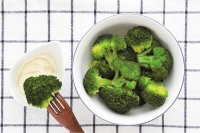
松岡 亮輔(まつおか りょうすけ)
【略歴】
キユーピー株式会社 研究開発本部 技術ソリューション研究所 評価・解析研究部 部長
1974年生まれ 北海道出身。九州大学大学院生物資源環境科学府 博士後期課程(社会人)修了。
1999年 キユーピー株式会社研究所入社。
2000年より健康機能に関する研究に携わり、野菜・サラダ、タマゴの健康機能研究と研究成果などの技術広報、特定保健用食品や機能性表示食品の申請、海外で健康栄養に関する学術活動などを行い、2022年より現職。
野菜は、ビタミン、ミネラルおよび食物繊維を豊富に含む食品である。栄養素の効果を効率的に発揮するためには、食べ方が重要となる。これまでにも、にんじんとマヨネーズを一緒に摂取するとにんじん中のβカロテンの吸収を高めること(23)、ブロッコリーとマヨネーズを一緒に摂取するとブロッコリーに含まれるルテインなどの吸収が高まったことが報告されている(24)。また、野菜はカルシウムが多く含まれていることが報告されているものの、シュウ酸が含まれていることからその吸収率は良くなく、良質なカルシウム源とはなっていないが(25、26)、食酢やマヨネーズがカルシウムの吸収を高めることが報告されている(27)。本研究成果と併せて、野菜の食べ方を工夫することにより、健康効果が期待できる。
野菜は、健康維持のために重要な食品である。サラダは、比較的調理が簡単でおいしく摂取できるメニューであることから、本研究がサラダを摂取することによって、健康の維持増進に貢献できることを期待する。

松岡 亮輔(まつおか りょうすけ)
【略歴】
キユーピー株式会社 研究開発本部 技術ソリューション研究所 評価・解析研究部 部長
1974年生まれ 北海道出身。九州大学大学院生物資源環境科学府 博士後期課程(社会人)修了。
1999年 キユーピー株式会社研究所入社。
2000年より健康機能に関する研究に携わり、野菜・サラダ、タマゴの健康機能研究と研究成果などの技術広報、特定保健用食品や機能性表示食品の申請、海外で健康栄養に関する学術活動などを行い、2022年より現職。
参考文献
(1)Maruyama C, Kikuchi N, Masuya Y, Hirota S, Araki R, Maruyama T, Effects of green-leafy vegetable intake on postprandial glycemic and lipidemic responses and α-tocopherol concentration in normal weight and obese men, J Nutr Sci Vitaminol, 2013, 59: 264-271.
(2)Imai S , Fukui M , Kajiyama S, Effect of Eating Vegetables Before Carbohydrates on Glucose Excursions in Patients With Type 2 Diabetes, J Clin Biochem Nutr, 2014, 54:7-11.
(3)金本郁夫, 井上裕, 守内匡, 山田佳枝, 居村久子, 佐藤眞治. 低Glycemic Index食の摂取順序の違いが食後血糖プロファイルに及ぼす影響. 糖尿病. 2010, 53 (2): 96-101.
(4)Aune D, Giovannucci E, Boffetta P, Fadnes LT, Keum N, Norat T, Greenwood DC, Riboli E, Vatten LJ, Tonstad S. F Fruit and vegetable intake and the risk of cardiovascular disease, total cancer and all-cause mortality-a systematic review and dose-response meta-analysis of prospective studies. Int J Epidemiol. 2017. 46(3): 1029-1056.
(5)Adebawo O, Salau B, Ezima E, Oyefuga O, Ajani E, Idowu G, Famodu A, Osilesi O. Fruits and vegetables moderate lipid cardiovascular risk factor in hypertensive patients. Lipids Health Dis. 2006. 5:14.
(6)Tian Y, Su L, Wang J, Duan X, Jiang X. Fruit and vegetable consumption and risk of the metabolic syndrome: a meta-analysis. Public Health Nutr. 2018. 21(4): 756-765.
(7)Lee M, Lim M, Kim J. Fruit and vegetable consumption and the metabolic syndrome: a systematic review and dose-response meta-analysis. Br J Nutr. 2019. 122 (7): 723-733.
(8)Zhang Y, Zhang DZ. Associations of vegetable and fruit consumption with metabolic syndrome. A meta-analysis of observational studies. Public Health Nutr. 2018. 21 (9): 1693-1703.
(9)Kartiko Sari I, Utari DM, Kamoshita S, Oktaviana D, Sakai S, Nishiyama H, Masuda Y, Yamamoto S. Increasing vegetable intake 400 g/day to control body weight and lipid profile in overweight hyperlipidemia menopausal women. J Public Health Res. 2020 Jul 28;9(3):1733.
(10)Saito I, Kokubo Y, Yamagishi K, Iso H, Inoue M, Tsugane S. Diabetes and the risk of coronary heart disease in the general Japanese population: the Japan Public Health Center-based prospective (JPHC) study. Atherosclerosis. 2011. 216 (1): 187-91.
(11)Thao TP, Linh NT, Nishiyama H, Sakai S, Shimura F, Yamamoto S. Higher Vegetable Intake Improved Blood Glucose Level in Vietnamese with Type 2 Diabetes Mellitus. 2017 Int J Clin Nutr Diet 3: 124.
(12)Sok Yen F, Shu Qin C, Tan Shi Xuan S, Jia Ying P, Yi Le H, Darmarajan T, Gunasekaran B, Salvamani S. Hypoglycemic Effects of Plant Flavonoids: A Review. Evid Based Complement Alternat Med. 2021. 2021: 2057333.
(13)Yamazaki T, Yamori M, Asai K, Nakano-Araki I, Yamaguchi A, Takahashi K, Sekine A, Matsuda F, Kosugi S, Nakayama T, Inagaki N, Bessho K; Nagahama Study Collaboration Group. Mastication and risk for diabetes in a Japanese population: a cross-sectional study. PLoS One. 2013. 8 (6):e64113.
(14)Sato A, Ohtsuka Y, Yamanaka Y. Morning Mastication Enhances Postprandial Glucose Metabolism in Healthy Young Subjects. Tohoku J Exp Med, 2019, 249: 193-201.
(15)瀬戸美江, 山田正子, 澤田嵩子, 藤本健四郎. 野菜350 g以上摂取のための繊切りキャベツ使用の有用性, 日本調理科学会誌, 2014, 47 (2): 90-96.
(16)木幡浩子, 原田努, 松久保隆, 高江洲義矩.市販加工食品の食感の唾液分泌および咀嚼時間に及ぼす影響. 日本栄養・食糧学会誌, 1987, 40 (4): 299-305.
(17)Kay RM. Dietary fiber.. J Lipid Res. 1982, 23 (2): 221-42.
(18)Jenkins DJ, Wolever TM, Leeds AR, Gassull MA, Haisman P, Dilawari J, Goff DV, Metz GL, Alberti KG. Dietary fibres, fibre analogues, and glucose tolerance: importance of viscosity. Br Med J. 1978 May 27;1(6124):1392-4.
(19)Uenaka S, Yagi M, Takabe W, Yonei Y. The effects of food materials on postprandial hyperglycemia. Glycative Stress Research 2020; 7 (3): 220-231.
(20)Horner KM, Finlayson G, Byrne NM, King NA. Food reward in active compared to inactive men: Roles for gastric emptying and body fat. Physiol Behav. 2016. 160: 43-49.
(21)遠藤美智子, 松岡孝, 食酢の食後血糖上昇抑制効果. 糖尿病. 2011. 54 (3): 192-199.
(22)西山博,田中知珠,松岡亮輔,宇都宮一典,ドレッシング摂取による血糖値への影響確認試験, 2023, 日本食品科学工学会 令和5年度関東支部大会
(23)Takeda S, Masuda Y, Usuda M, Marushima R, Ueji T, Hasegawa M, Maruyama C, Effects of mayonnaise on postprandial serum lutein/zeaxanthin and beta-carotene concentrations in humans, J Nutr Sci Vitaminol, 2009, 55, 479-485.
(24)Takeda S, Kimura M, Marushima R, Takeuchi A, Takizawa K, Ogino Y, Masuda Y, Kunou M, Hasegawa M, Maruyama C, Mayonnaise contributes to increasing postprandial serum β-carotene concentration through the emulsifying property of egg yolk in rats and humans, J Nutr Sci Vitaminol, 2011, 57: 209-125.
(25)Chai W, Liebman M, Effect of different cooking methods on vegetable oxalate content. J Agric Food Chem. 2005, 53(8):3027-30.
(26)小川竜平, 真鍋厚史, 中山貞男, 小口勝司, カルシウムとリンの吸収ならびに実験的骨粗鬆症に対するシュウ酸、酒石酸の影響. 昭和医学会誌, 1994, 54 (2): 118-127.
(27)Ji S, Masuda Y, Kimura M, Wang W, Li C, Xi Y. Effects of mayonnaise on calcium absorption in rats, J Shandong Agr Unuv, 2019, 50 (6): 959-963, in Chinese.










